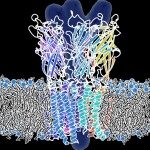Link to Pubmed [PMID] – 7538429
Link to DOI – 10.1038/nsb0295-163
Nat Struct Biol. 1995 Feb;2(2):163-70.
A new computational procedure which simultaneously provides gap closure and side-chain positioning in homology modelling is described. It uses a database search scheme to generate fragments to model gaps, a rotamer library to define side-chain conformations, and iteratively refines a conformational matrix CM, such that its elements CM(i,j,o) and CM(i,j,k) give the probabilities that the backbone of residue i adopts the conformation described by fragment j and that its side-chain adopts the conformation of its possible rotamer k. Each residue experiences the average of all possible environments, weighted by their respective probabilities. The method converges, thereby deserving the name of ‘self consistent mean field’ approach.

